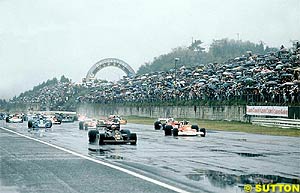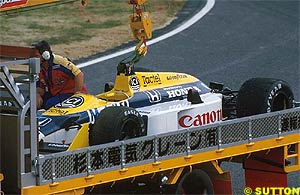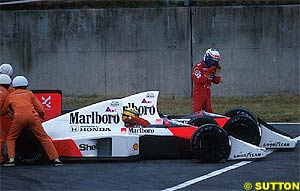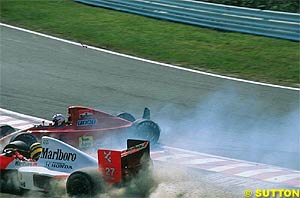
Atlas F1 Contributing Writer
Usually the final race of the season, the Japanese Grand Prix has provided racing fans with several unforgettable races: the dramatic title-deciding 1976 Grand Prix at Fuji, or the controversial clashes between Alain Prost and Ayrton Senna among others. Journalist and historian Doug Nye takes a look back at the races in the land of the rising sun
Japan's motor industry was already well on the way to establishing somewhat similar domination - certainly of world export markets - in the mid-1970s when Formula One first staged a World Championship-qualifying round upon the islands, but that same motor industry had simply been hammering upon the door of western markets in the early 1960s when Honda created its splendid testing facility and racing circuit at Suzuka.
From lessons learned with this basis - like, for example, "Frippin' 'eck, we can do bettah than this!" - their engineers directed by Soichiro Honda and Yoshio Nakamura developed their first gold-lacquered 1 ½-litre transverse V12-engined F1 prototype. At Suzuka it was tested by - amongst others - none other than Cooper's double-World Champion Driver, Jack Brabham.
At the end of 1962 the first Grand Prix race to be organised with international participation at Suzuka had been contested by sports-racing cars, and victory fell to Peter Warr, later racing director of Team Lotus, visiting with his little Lotus 23. Honda's first 1½-litre Grand Prix car made its Formula One debut in the 1964 German Grand Prix at far away Nurburgring, and despite being viewed with some amusement at the time by the European motor-racing community, by the end of that Formula in 1965 the works Honda was a winner, as driven by Richie Ginther and American relative obscurity Ronnie Bucknum.
The first Formula One World Championship-qualifying Japanese Grand Prix was run at Fuji in 1976. The organisers simply experienced too much luck. Their race proved to be the deciding round of that sensational season, the great final shootout between Niki Lauda and James Hunt, Ferrari and McLaren. All eyes were focused upon the barren circuit under the shadow of the sacred volcano, but the race was riven by torrential rain and bad light, the start was delayed and delayed, drivers and teams were split between actually starting at all or calling it off.
Ultimately the race was flagged away in streaming conditions just short of the earlier race-postponing flood, and immediately Niki Lauda opted out of the battle. "It's up to James now", he said. Up to James and Lady Luck. He had a tyre puncture, he lost the lead, lost his chance of World Champion glory, battered his way back into the race, kicked the door down, and finished well enough to secure the points advantage required. He was World Champion, there in the chill, dank dusk that enveloped that Japanese mountainside. Most people seem to forget who actually won that race - Mario Andretti, announcing Team Lotus's return to the top.
No further Formula One Japanese Grand Prix was run for over ten years, in fact until the time it was first staged at Suzuka in 1987. By that time Honda were winning Grands Prix again, providing the turbocharged V6-cylinder power for battling Williams-Honda teammates Nigel Mansell and Nelson Piquet - between whom the World Championship battle was finely poised.
His apparently enforced (!) defection simply handed teammate Piquet a still well-deserved World Championship title, the third and last of the happy-go-lucky Brazilian's glittering career. This despite his retirement from the race itself, which fell to Gerhard Berger's Ferrari ahead of Senna's Lotus-Honda, Berger then staging something of a comeback for La Ferrari emulating Lotus's with Andretti at Fuji '76.
By 1988, Honda's eggs were all in the McLaren basket and their internecine battle for the Championship title that season lay between teammates - and increasingly enemies - Ayrton Senna and Alain Prost. Senna soared back through the field after almost stalling at the start to take the first of his three World titles with a magnificent victory.
Suzuka had immediately established itself as something of a favourite with the drivers, lengthy, tricky, demanding, satisfying, the Hugenholtz-designed circuit configuration was all these things. It also seemed each year to be producing good, close racing - not only in Formula One but in almost any other category which was campaigned there.
Then in 1989, Prost and Senna faced each other for the last time as McLaren teammates. Prost made a subtle aerodynamic change to his car's set-up on the starting grid and found the advantage of rather more straight-line speed than was available for Senna's. Prost drew away, leaving the capacity crowd absolutely entranced as Senna drove his heart out to claw his way onto terms with 'Tadpole'.
Senna lived and breathed his job. To him that World Championship was the core focus of his being. He would not relax - he would not relent - he reeled-in his teammate, and rival. He finally clung tightly onto the tail of Prost's car rocketing through Suzuka's famous flat-out '130R' left-hander before the pits and then pulled out level in a desperate attempt to outbrake the Frenchman into the almost ridiculously tight chicane entering the start/finish straight.
He - perhaps justifiably - slammed shut the door. The two McLarens collided wheel-to-wheel and slithered to a halt, entwined, on the triangular chicane outfield. Prost, confident the World Championship was his, simply shucked off his belts and strode from the scene. Senna, beckoning the uniformed marshals to help him restart, returned to the fray - fuming.
Despite a pit stop to fit a replacement nose section, he managed to catch and pass Alessandro Nannini's Benetton to be first past the chequered flag - only to be disqualified for negotiating the chicane incorrectly as he manouevred to rejoin the race. So the Italian Benetton driver - Nannini - was awarded victory.
His Suzuka exclusion festered in Senna's mind and was responsible in part for Senna's failure to win the 1989 World Championship, punctuating his sequence of success that would have otherwise seen him win four titles before his death at Imola in 1994. The Brazilian driver smouldered with indignation, contending that Prost and the sport's governing body were in cahoots against him. Paranoid? Not until everybody had turned against him.
Suzuka was the scene of one of the most remarkable accidents in motor-racing history. Prost, by now driving for Ferrari, had to win the Japanese Grand Prix to retain an outside chance of winning the Championship title. Yet his chance was stolen when Senna simply ran him off the road into the gravel trap at the very first corner. a chilling example of the Brazilian's obsessive, driven, nature and one which had I for one been in authority that day would have had him facing a charge of bringing the sport into disrepute.
The validity of any such charge was proven the following year, when Senna demonstrated the other side of his complex character - again at Suzuka, moving aside to hand victory to his latest McLaren teammate, Gerhard Berger. Senna clearly felt that it was enough to have been crowned World Champion for the third time, then told the press in some detail the bitter intent behind his move on Prost the year before.
Senna suffered a major sense of humour failure, and post-race in the paddock when Irvine showed no contrition - even less respect - punches were thrown to Japanese puzzlement and shock.
Then in 1994's Japanese Grand Prix, Senna was dead and it was Damon Hill who scored his brilliant victory in the rain for Williams-Renault, winning ahead of Michael Schumacher's Benetton. Schumacher made the top step of the podium in 1995, but in 1996 it was at Suzuka that Damon Hill scored his great victory - leading from start to finish to clinch his World Championship title, and leave hardly a dry eye in any British enthusiast's household.
And since then there have been the Villeneuve Williams-Renault year, the McLaren/Ferrari duels and now the Ferrari Formula One road show rolls back in to this hospitable and challenging venue. Our season approaches its conclusion. Memories? Well, we've had a few.
Well now, here we are at the last gasp of what has been a brilliant season statistically for Ferrari - something of an own-goal politically and presentationally - and a spectacular demonstration of under-achievement from those who should have provided Maranello and its supreme Numero Uno with something approaching respectable competition.
 As has been described and discussed at some length in Atlas F1's wonderful Nostalgia Forum - which if you have not yet visited you really should, you might enjoy it - Suzuka was designed for Honda by the Dutch specialist John Hugenholtz, father of the Zandvoort circuit, erstwhile seaside home of the now long-lamented Dutch Grand Prix. In its earliest days, this sinuous figure-of-eight circuit provided a searching test-ground for motorcycle development and proving, and it was also there that Honda ran their first exploratory toe-dip into the world of Formula One, using a Cooper-Climax Type 53 'Lowline' car which they had commissioned and imported specially.
As has been described and discussed at some length in Atlas F1's wonderful Nostalgia Forum - which if you have not yet visited you really should, you might enjoy it - Suzuka was designed for Honda by the Dutch specialist John Hugenholtz, father of the Zandvoort circuit, erstwhile seaside home of the now long-lamented Dutch Grand Prix. In its earliest days, this sinuous figure-of-eight circuit provided a searching test-ground for motorcycle development and proving, and it was also there that Honda ran their first exploratory toe-dip into the world of Formula One, using a Cooper-Climax Type 53 'Lowline' car which they had commissioned and imported specially.
 Frenetic and dramatic as ever, pressing desperately hard for the fastest time in qualifying, Mansell crashed heavily into the right-side tyre wall in the fast, flowing, deceptive and demanding S-bends behind the paddock. Although the Didcot team repaired his car for the following day's practice session, Mansell, who had been briefly held in hospital, discharged himself and returned to Europe suffering from an injured back.
Frenetic and dramatic as ever, pressing desperately hard for the fastest time in qualifying, Mansell crashed heavily into the right-side tyre wall in the fast, flowing, deceptive and demanding S-bends behind the paddock. Although the Didcot team repaired his car for the following day's practice session, Mansell, who had been briefly held in hospital, discharged himself and returned to Europe suffering from an injured back.
 This was widely regarded as being the only realistic overtaking opportunity for near-equal cars, but to succeed Senna's habitual level of intimidation had to prevail upon Prost - who had to be compliant. With the Championship at stake between them, Prost proved anything but.
This was widely regarded as being the only realistic overtaking opportunity for near-equal cars, but to succeed Senna's habitual level of intimidation had to prevail upon Prost - who had to be compliant. With the Championship at stake between them, Prost proved anything but.
 In 1992, Nigel Mansell's engine failed after he allowed his Italian Williams-Renault teammate to take the lead there. In 1993 Senna, leading the race in his McLaren-Ford, found cocky new kid on the block Eddie Irvine racing his McLaren-Ford as he lapped the Ulsterman's Jordan-Hart.
In 1992, Nigel Mansell's engine failed after he allowed his Italian Williams-Renault teammate to take the lead there. In 1993 Senna, leading the race in his McLaren-Ford, found cocky new kid on the block Eddie Irvine racing his McLaren-Ford as he lapped the Ulsterman's Jordan-Hart.
Please Contact Us for permission to republish this or any other material from Atlas F1.
|
Volume 8, Issue 41
Atlas F1 Exclusive
Niki Lauda: No Boundaries
Renault's Off Season
Jo Ramirez: a Racing Man
Japanese GP Preview
Japanese GP Preview
Local History: Japanese GP
Japan Facts & Stats
Columns
The Japanese GP Quiz
Bookworm Critique
Rear View Mirror
Elsewhere in Racing
The Grapevine
> Homepage |